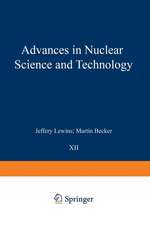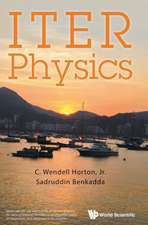The Chemistry of Fusion Technology: Proceedings of a Symposium on the Role of Chemistry in the Development of Controlled Fusion, an American Chemical Society Symposium, held in Boston, Massachusetts, April 1972
Editat de D. Gruenen Limba Engleză Paperback – 9 ian 2012
Preț: 645.14 lei
Preț vechi: 758.99 lei
-15% Nou
Puncte Express: 968
Preț estimativ în valută:
123.46€ • 127.54$ • 102.75£
123.46€ • 127.54$ • 102.75£
Carte tipărită la comandă
Livrare economică 25 martie-08 aprilie
Preluare comenzi: 021 569.72.76
Specificații
ISBN-13: 9781461345978
ISBN-10: 1461345979
Pagini: 412
Ilustrații: XIV, 394 p.
Dimensiuni: 152 x 229 x 22 mm
Greutate: 0.55 kg
Ediția:Softcover reprint of the original 1st ed. 1972
Editura: Springer Us
Colecția Springer
Locul publicării:New York, NY, United States
ISBN-10: 1461345979
Pagini: 412
Ilustrații: XIV, 394 p.
Dimensiuni: 152 x 229 x 22 mm
Greutate: 0.55 kg
Ediția:Softcover reprint of the original 1st ed. 1972
Editura: Springer Us
Colecția Springer
Locul publicării:New York, NY, United States
Public țintă
ResearchDescriere
Nuclear energy obtained from thermonuclear fusion of light nuclei is a goal to which an increasing world-wide effort is being committed. The demands on energy reserves and resources are continually increasing as ever more coun tries achieve modern industrial status. All projections agree that conventional means of energy production must be supplemented and indeed supplanted by new methods. Only the date at which the transition becomes imperative is subject to debate. The promise of fusion energy ultimately to pro vide a clean, cheap, dependable and potentially inexhaustible energy source augurs well for the future of the human race. If there were illusions at the start of the quest for controlled thermonuclear power that solutions would be easily found, the past two decades have dlspelled them. Unwarranted optimism has been replaced by a realistic recognition of the immense scientific and technological challenges that arise in bringing about practical fusion energy. Broadly speaking, problems can be put into two categories--those having to do with heating the fuel to thermonuclear temperatures at high enough particle densities and for sufficiently long confine ment times to yield a net power return and those having to do with the actual construction of a power producing fusion reactor.
Cuprins
Fusion Energy and the Future.- Tritium Breeding and Direct Energy Conversion.- A Review of the Chemical, Physical, and Thermal Properties of Lithium that are Related to Its Use in Fusion Reactors.- Molten Salts as Blanket Fluids in Controlled Fusion Reactors.- Fusion Reactor Fuel Processing.- Chemical Effects of Plasma Interactions with Thermonuclear Reactor Surfaces.- Diffusion and Permeation of Hydrogen Isotopes in Fusion Reactors.- Condensed Phase Metal-Hydrogen Systems and Their Role in Controlled Fusion Reactors.- Chemical Aspects of New Superconducting Materials and Fabrication Techniques.- Experiments Leading to Laser Induced Fusion.



















